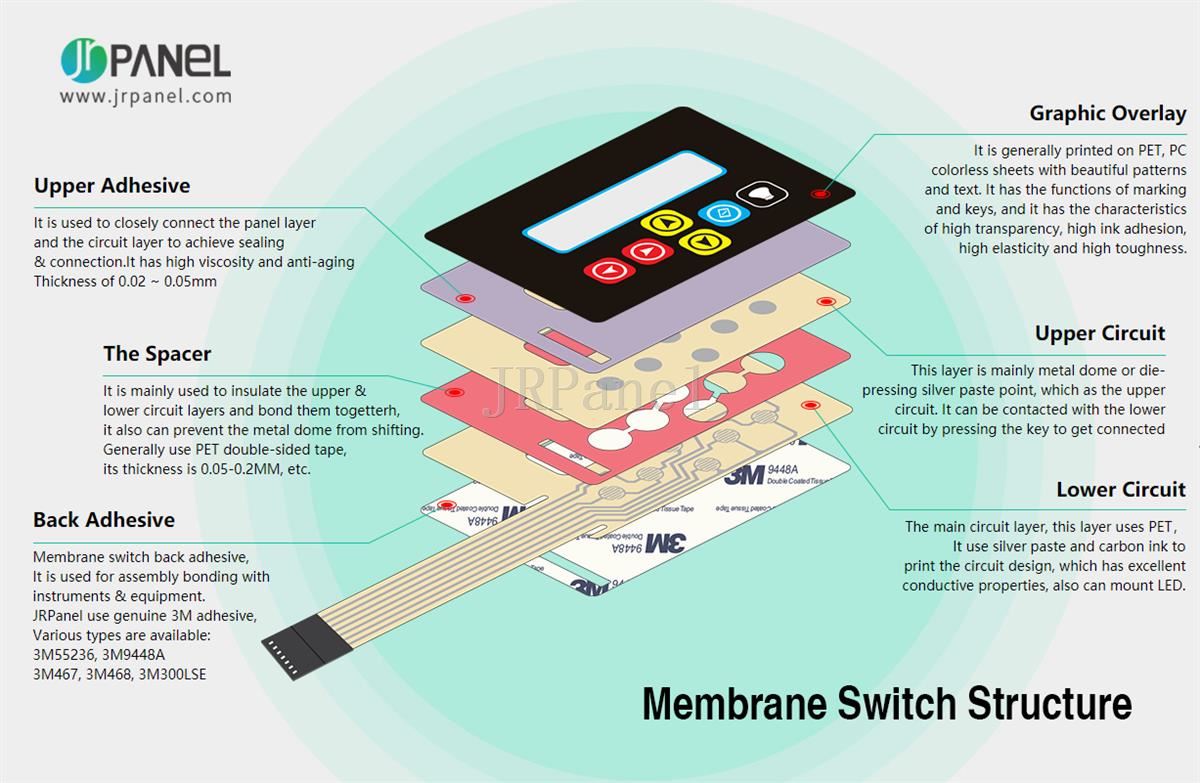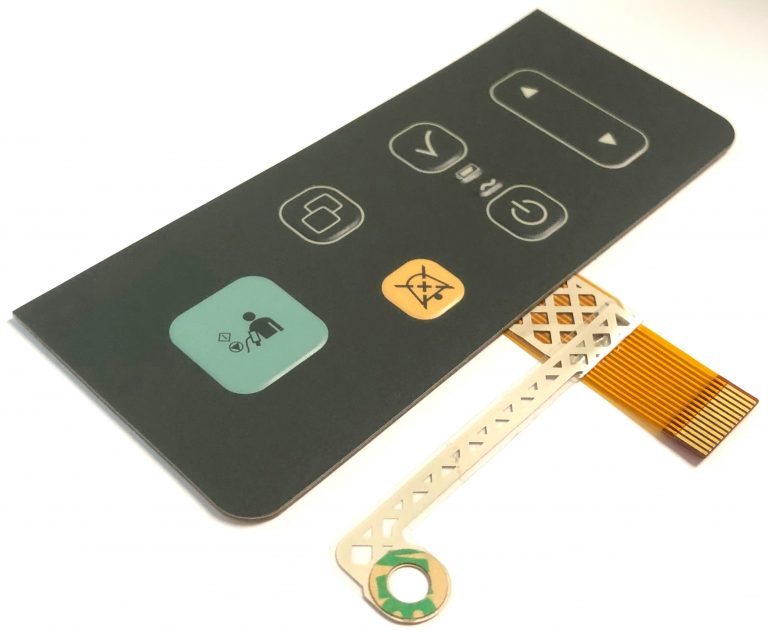Everything About Membrane Switch Over: A Comprehensive Overview for Beginners
Membrane buttons are essential parts in contemporary electronic devices, providing an unique user interface for individual interaction - membrane switch. Their layered building and construction, including overlays and conductive traces, supplies capability and resilience. Unlike standard mechanical buttons, membrane layer buttons provide a streamlined style and adjustable options. Recognizing their crucial features and benefits can transform item design. However, the ins and outs of their application and layout considerations warrant more expedition
What Is a Membrane layer Change?
A membrane switch is a sort of electric switch that contains a versatile membrane layered over a printed circuit board. This design permits a smooth and small user interface, typically utilized in different digital gadgets. Membrane layer switches are generally found in customer devices, clinical devices, and commercial equipment because of their sturdiness and resistance to environmental factors.The building and construction commonly includes several layers, such as visuals overlays and adhesive backing, which give responsive comments and shield the circuitry below. The operation of a membrane layer switch is initiated when pressure is related to the surface, completing an electric circuit.These switches are valued for their flexibility, making it possible for customized styles and printed graphics that deal with details individual interfaces. Their inconspicuous nature lowers area needs, making them perfect for applications where standard buttons may not fit. Generally, membrane layer buttons offer a functional and aesthetic remedy for modern-day digital tools.
Secret Components of Membrane Switches Over
Membrane layer switches make up a number of crucial elements that add to their performance and performance. The leading layer, recognized as the overlay, gives the customer interface and is typically published with icons or graphics. Underneath the overlay exists a spacer layer, which separates the conductive elements and avoids unintended activation. The following essential part is the graphic layer, which improves appearances and assures the durability of the design.Conductive traces, normally made from materials like silver or carbon, are published on the circuit layer. When stress is related to the overlay, these traces come right into get in touch with, finishing the circuit. In addition, a backing layer uses architectural support and can be made from products such as polyester or polycarbonate. Together, these parts produce a dependable, user-friendly user interface ideal for different applications, from house devices to industrial devices. Understanding these aspects is essential for any person thinking about membrane button technology.
How Membrane Layer Switches Work
Comprehending exactly how membrane switches feature is important for appreciating their extensive use in different devices. A membrane switch operates through a series of layers, including a visuals overlay, spacer, and a circuit layer. When stress is applied to the overlay, it compresses the spacer layer, enabling the circuit layer to make get in touch with and finish an electrical circuit. This action sends a signal to the gadget, motivating a response, such as switching on a light or turning on a function.Membrane switches over can be created with various attributes, including responsive comments, backlighting, and custom-made graphics, boosting user interaction. Their building enables a closed style, safeguarding the internal elements from dirt, wetness, and impurities. This sturdiness makes them appropriate for diverse applications, from customer electronic devices to industrial tools. On the whole, the simpleness and effectiveness of membrane changes contribute to their appeal in modern innovation.
Advantages of Membrane Switches Mechanical Buttons
While mechanical switches have long been a staple in many tools, membrane layer switches deal distinctive advantages that make them increasingly appealing. One substantial advantage is their slim account, permitting even more compact designs and higher adaptability in product advancement. Additionally, membrane layer switches feature a consistent surface area, which enhances aesthetic allure and streamlines cleaning, making them appropriate for settings where hygiene is critical.Another advantage is their resistance to dirt and dampness. Unlike mechanical buttons, which can be endangered by environmental factors, membrane layer switches give a sealed interface that safeguards versus pollutants - membrane switch. In addition, membrane layer buttons generally have a longer life expectancy as a result of fewer moving parts, causing improved toughness and reliability.Cost-effectiveness is additionally a noteworthy benefit, as membrane switches can be generated wholesale with lower production expenses. These aspects integrate to position membrane layer switches as a useful click over here now alternative to conventional mechanical choices in different applications
Typical Applications of Membrane Switches Over
Membrane buttons are extensively utilized in numerous sectors, specifically in consumer electronic devices and industrial control panels. In customer devices, they provide a sleek, user-friendly user interface, while in commercial setups, they boost longevity and performance. Recognizing these applications highlights the versatility and usefulness of membrane switches in modern-day technology.
Customer Electronic Devices Gadgets
As consumer electronics remain to advance, membrane switches have actually come to be a preferred selection for a range of devices as a result of their versatility and smooth style. These switches are commonly discovered in smart devices, tablet computers, and remote controls, where room is restricted and looks matter. Their low profile and customizable layouts allow manufacturers to create user-friendly user interfaces that boost the overall customer experience. In addition, membrane buttons are frequently utilized in devices such as microwaves and coffee machine, giving instinctive control options while standing up to moisture and Web Site dirt. The resilience and reliability of membrane layer changes make them suitable for daily customer products, guaranteeing long life and constant efficiency. Generally, their integration in customer electronic devices shows a mix of performance and modern layout.
Industrial Control Panels
The applications of membrane changes expand beyond customer electronics, locating significant usage in commercial control board. These buttons are preferred for their sturdiness and resistance to severe settings, making them optimal for making and procedure control settings. They give a reputable interface for operators to control machinery, display processes, and readjust settings. Membrane buttons can be customized to fit particular functional requirements, incorporating features like backlighting and tactile comments, boosting user experience. Their low-profile design permits assimilation into different tools, while their ability to endure spills, dirt, and severe temperatures assurances durability. On the whole, membrane layer switches add to effective and risk-free operation in commercial applications, showing their adaptability and performance sought after settings.
Factors To Consider for Creating Membrane Layer Switches
When creating membrane switches, picking the right products is vital to assure toughness and capability. Furthermore, comprehending layer configuration methods can greatly impact the button's performance and user experience. These factors to consider play an important function in creating effective and dependable membrane layer switch styles.
Material Choice Value
Product choice plays an important function in the layout and functionality of membrane switches. The picked materials straight affect the switch's sturdiness, tactile reaction, and overall visual. Secret considerations include the substrate, which should give structural integrity while permitting versatility, and the visuals overlay, which needs to be resistant to use and environmental elements. Conductive products must guarantee dependable electrical performance, while adhesives need to use solid bonding without endangering the switch's operation. In addition, compatibility with producing processes and end-user environments is vital; materials should hold up against differing temperatures, moisture degrees, and chemical exposure. Eventually, ideal material option not just boosts the membrane layer switch's performance however also adds to its long life and individual fulfillment, making it an essential facet of the style procedure.

Layer Setup Strategies

Often Asked Concerns
The Length Of Time Do Membrane Layer Switches Over Generally Last?
Membrane buttons generally have a life expectancy of 1 to 5 million cycles, depending upon usage and environmental problems. Elements such as style high quality and operating regularity considerably influence their resilience and general efficiency longevity.

Can Membrane Layer Switches Over Be Custom-made for Details Styles?
Membrane buttons can certainly be personalized to fit certain styles, permitting for diverse forms, shades, and performances. This versatility allows manufacturers to tailor these switches to satisfy distinct aesthetic and functional demands successfully.
What Materials Are Used in Membrane Switch Construction?
Membrane layer buttons are generally constructed making use of products such as polyester, polycarbonate, and glue layers. These materials give flexibility, longevity, and resistance to ecological variables, ensuring the switches work effectively in various applications and conditions.
Are Membrane Layer Switches Over Water Resistant or Resistant to Wetness?
Membrane switches can be made to be moisture-resistant, utilizing specialized coatings and materials. Their water-proof abilities depend on building and construction top quality and specific applications, making it vital to assess demands for excellent efficiency in various settings.
Exactly How Are Membrane Layer Switches Repaired if Harmed?
Repairing damaged membrane layer switches normally includes changing the impacted layer or circuit. Service technicians may additionally apply conductive adhesive or make use of specialized repair work sets, ensuring functionality is brought back without complete substitute of the entire switch assembly. Unlike typical mechanical buttons, membrane switches provide a smooth style and customizable options. A membrane layer button is a type of electric button that consists of a flexible membrane layer layered over a published circuit board. The procedure of a membrane switch is initiated when pressure is used to the surface area, finishing an electrical circuit.These switches are valued for their flexibility, making it possible for custom-made styles and published graphics that provide to specific customer interfaces. While mechanical switches have actually long been a staple in many gadgets, membrane layer switches offer distinct advantages that make them progressively appealing. Membrane buttons commonly have a longer life expectancy due to less moving parts, resulting in boosted durability and reliability.Cost-effectiveness is also a significant benefit, as membrane layer buttons can be produced in mass with reduced manufacturing costs.